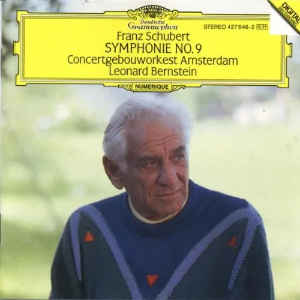
Franz Schubert (1797-1828)
Symphony No.9 in C, D.944 ‘The Great’ (1826)
Concertgebouworkest Amsterdam/Leonard Bernstein
rec. live, October 1987, Grote Zaal, Concertgebouw, Amsterdam
Presto CD
Deutsche Grammophon 427 646-2 [50]
Owing to ongoing and sustained confusion about how to number Schubert’s symphonies and when they were actually written, let us just say that this is D.944, his last.
Bernstein takes a relaxed approach to this majestic work, being not as interventionist as he sometimes was as a conductor, content to sit back and take the Rolls Royce which is the Concertgebouw for a spin. He was in more rhythmically incisive mood for his earlier recording with the New York Philharmonic – but that is not to say that this performance is in any way slack or boring; tempi are conventional but I can picture Bernstein swinging along on the podium to the waltz in the Scherzo and there is no shortage of energy or attack in the opening to the finale – and unsurprisingly, in it he seems to bring out even more obviously Schubert’s quotation from the “Freude, schöner, Götterfunken” chorus in Beethoven’s Choral Symphony. The sound engineering matches the opulence of this reading: warm, rich and resonant with absolutely no indication that this was live.
When I reviewed Marek Janowski’s studio recording of the last two symphonies in June last year, I made some observations regarding the numbering issue and several comparisons with previous recordings of ‘The Great’ back to Knappertsbusch, Szell and Sinopoli – and found very much in favour of that last with the Staatskapelle Dresden. He did not take the repeats, nor does Bernstein, and although I am usually in favour of completeness and following the composer’s wishes, on this occasion I am inclined to think that their omission is artistically advisable, as Schubert’s symphonic invention was obviously not that of mature master, given that he was not yet thirty when he embarked upon his composition . I revisited both Bernstein’s 1967 recording and Sinopoli to check my reactions and as much as I enjoy both, I think the DG digital sound, superior to the Sony recording, and the grandeur of its conception make it a very viable alternative to the dynamism and excitement of the young Bernstein’s direction. Likewise, Sinopoli’s version, made only five years after Bernstein’s later account, remains a very close cousin to it; tempi are similar -and I would not want to have to choose among all three.
Ralph Moore
Help us financially by purchasing from



















